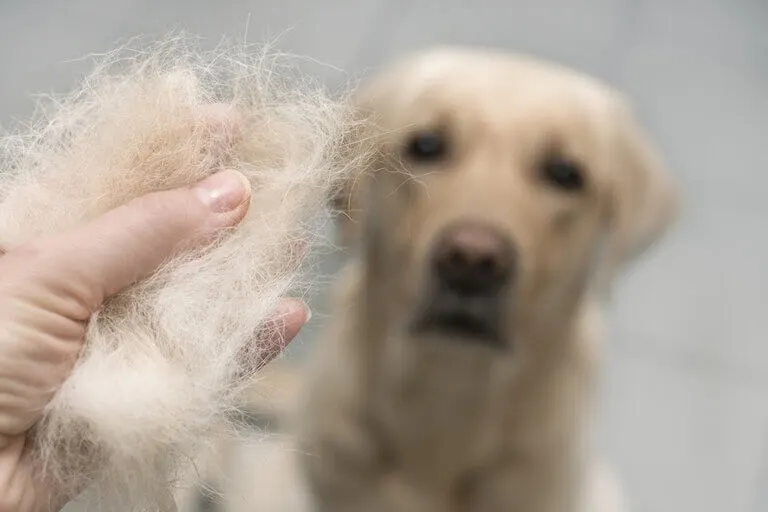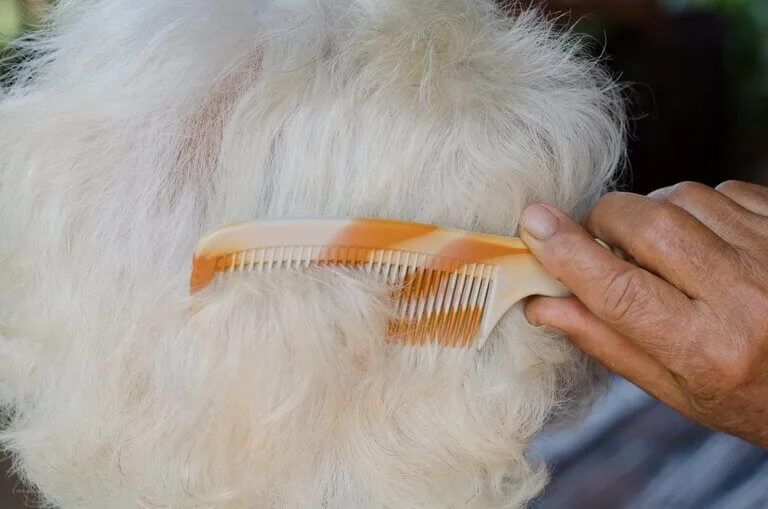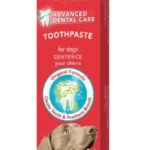Are you tired of finding dog hair everywhere, from your favorite couch to your freshly laundered clothes? The best dog food for shedding might feel like a miracle for you right now. Finding the best dog food for shedding is important in managing your canine companion’s fluffy tumbleweeds.
First, shedding is a normal part of a dog’s life. It’s how they naturally renew their fur and maintain their coat. However, when your home looks more like a fur salon than a living space, it is time to seek solutions.
Understanding Dog Shedding: The Unseen Tales of Fur
Many owners worry not just about the mess but also about what excessive shedding might say about their pet’s health. What if the food you pour into your dog’s bowl every morning could help you win this furry battle?
Research reveals that a dog’s diet can significantly influence the amount and health of their coat. You could turn the tide on shedding by choosing the right food, packed with vital nutrients for skin and hair health.
Various Types of Shedding
Much like the leaves in autumn, a dog’s fur can experience its seasons. There are two main types of shedding. First is the continuous shedding, the kind of shedding that happens year-round. Whether it’s summer or winter, these breeds, like Labrador Retrievers, will leave their mark everywhere.
The second type is seasonal shedding, which occurs mainly during specific times. It happens mainly during the spring and fall. Breeds with thick undercoats, such as Huskies, usually blow their coats twice yearly as a natural response to changing temperatures.
What Affects Your Dog’s Shedding?
Several contributors determine the extent of shedding in dogs.
- Breed is the most apparent factor, as some dogs are genetically tailored to have more hair. Therefore, they shed more.
- Age also plays a role in shedding; as dogs age, their fur’s growth cycle changes, sometimes leading to increased shedding.
- Health status is critical — various conditions, from allergies to thyroid problems, can lead to excessive shedding.
- Diet is a less obvious but influential factor. A lack of nutrients like omega fatty acids can make a dog’s coat dull and more prone to shedding.
When Shedding Spells Trouble: The Signs to Watch For
Shedding is normal, but it’s time to take notice when it crosses into excessive territory. Keep an eye out for bald spots, vigorous scratching, or skin that appears irritated or inflamed. These are typical indicators that the shedding may be rooted in a health issue.
Remember, while shedding can be a nuisance, it’s a sign that your dog’s body is functioning as it should. However, if you’re concerned about the amount of fur flying around, it’s always best to consult your veterinarian. They can help you pinpoint any underlying issues and guide you toward giving your furry friend the best care — inside and out.
The Diet-Shedding Connection: Feeding Your Dog for a Glossier Coat
A proper diet is instrumental in maintaining your dog’s shiny coat and mitigating the onslaught of annoying fur. Like humans, dogs require a balanced diet with essential nutrients to keep their skin healthy and their hair follicles firmly rooted.
The nutrients act like a shield, protecting against excessive shedding and ensuring the fur that does fall is part of a natural and healthy renewal process. So, what exactly is the best dog food for shedding, and how does it help?
Essential nutrients play pivotal roles in cultivating a shiny canine coat. Omega-3 and omega-6 fatty acids are necessary to avoid unnecessary shedding. They bolster the skin’s health, making it a formidable barrier and providing oils that keep the fur sleek and strong. Dogs also benefit from a cocktail of vitamins such as A, E, and B-complex. Minerals like zinc also help galvanize the skin’s defenses and aid in repair and regrowth.
Allergens to Watch Out For
Finding the best dog food for shedding is not just about what to include but also what to exclude. Certain foods can be the culprits behind aggravated shedding, often due to allergic reactions.
What do vets recommend for shedding? “Food allergies are one of the most common causes of chronic skin and digestive problems in dogs. Common food allergens include beef, chicken, dairy, wheat, corn, and soy. If you suspect your dog has a food allergy, it’s important to work with your veterinarian to identify the trigger and develop a dietary elimination trial.” Dr. Jennifer
Veterinarians often advise avoiding common allergens like corn, wheat, soy, and specific proteins. If your dog is incessantly scratching or shedding more than usual, scrutinizing their diet for these potential irritants should be a priority.
What should I give my dog to stop shedding?
Consider alternatives to the usual suspects for dog allergens, such as hypoallergenic dog foods or a novel protein source your dog has not been exposed to. This and a vigilant eye on the ingredient list can make all the difference.
Do eggs help dogs stop shedding? Eggs can be a protein-rich snack with beneficial vitamins and minerals. Nevertheless, feed your dogs eggs in moderation, as they can also trigger allergies in some dogs.
A diet that keeps shedding at bay in canines is not about a single ingredient but rather a holistic approach to nutrition tailored to your dog’s needs. Get well-acquainted with labels and keep that vacuum in the closet a little longer by choosing a diet that promotes health, inside and out. The key is to ensure your dog’s diet is balanced and meets all its nutritional needs.
A Guide to the Best Dog Food for Shedding

Choosing the right dog food to combat shedding involves a comprehensive approach, considering various key factors. Below is a detailed exploration of how to navigate the vast pet food market to find the nutritional choice that helps maintain your dog’s coat health.
Age and Life Stage Matters
Different life stages require specific nutrients. Puppies, for example, need high-calorie, protein-rich food to support their growth, whereas seniors might require a lower-calorie diet to prevent weight gain. What food is good for dog hair loss in a young, active dog may differ from that needed by an aging pet with a slower metabolism.
Breeds Have Specific Needs
Each dog breed has unique requirements due to their genetic makeup. For instance, breeds with long coats may need additional omega fatty acids to keep their fur shiny and reduce shedding. Some breeds may also be predisposed to food sensitivities that accentuate hair loss, and they should have a diet that mitigates these concerns. You can read more about the Chihuahua breed if you have one.
Recognizing Underlying Health Conditions
Certain medical issues like thyroid problems or dermatitis can exacerbate shedding. It’s crucial to choose dog food with the right nutrients tailored to combat any health conditions that might affect your dog’s coat.
Ingredient Quality and Protein Sources
Protein is the building block of a dog’s fur, so a high-quality source of protein should be the main ingredient in your dog’s diet. Look for food that lists real meat, poultry, or fish as the first ingredient. Foods with whole, identifiable ingredients tend to be beneficial for a healthy coat.
There’s a debate over whether grain-inclusive or grain-free diets are best. What food is good for shedding might depend on a dog’s grain sensitivities. While some dogs thrive on whole grains, others might need grain-free options due to allergies or intolerances.
The best action when selecting dog food for shedding dogs is to consult a veterinarian. They can provide personalized recommendations based on your pet’s health profile and nutritional needs.
Sifting Through the Brands
Consider a mix of budget-friendly and premium dog food brands that cater to shedding. Affordable options like the Purina Pro Plan are formulated with a variety of protein sources and essential nutrients.
At the premium end, brands like Orijen present high-protein recipes that mirror a dog’s natural diet. Royal Canin and Hill’s Science Diet also offer breed-specific formulas that effectively target shedding issues.
Transitioning With Care
Remember that individual results with dog food can vary greatly, and any diet change should be gradual to prevent digestive upset. A gentle transition allows your pet’s digestive system and coat to adjust without adverse reactions.
By considering these factors and selecting a suitable food brand, you empower your dog to live a healthier, shinier life with minimal shedding. Remember, when it comes to what food is good for shedding, it’s about striking the perfect balance that complements your dog’s needs.
The Shedding Solution: Beyond the Bowl
Controlling dog shedding goes beyond careful dietary choices; it calls for a well-rounded care routine. By asking, “How can I control dog shedding around the house?” you’re stepping into a proactive role as your pet’s caretaker. Regular brushing is crucial—it removes excess fur and distributes natural skin oils throughout the coat. Aim to brush your dog several times a week or daily for heavy shedders, using the correct brush type for your dog’s coat.
Maintaining a healthy weight is another vital component. Excess pounds can strain your dog’s overall health, including the skin and coat, leading to increased shedding. Combine regular exercise with precise portion control to keep your canine companion lean and vibrant.
Managing your dog’s stress and allergies is also key. Dogs can shed more when they’re anxious or having allergic reactions. Minimize stress with a stable routine and plenty of physical and mental stimulation. For allergies, identifying and avoiding triggers are essential; your vet can guide you on this path.
Finally, consider supplements promoting coat health, but always consult your vet first. They can recommend specific products, like omega-3 fatty acid supplements, to enhance skin and coat condition with a balanced diet.
By embracing these additional tips and integrating them with a nourishing diet, you can make “How can I control dog shedding around the house?” a question of the past.
The Top Three Dog Foods for Reducing Shedding
The market is full of dog food options claiming to aid coat health. While there are other good options, I’ve narrowed down the top three foods that dog owners swear have made a visible difference in reducing excessive shedding.
1. Orijen Six Fish
It’s packed with high-quality fish proteins, including mackerel, herring, and flounder. They offer a bounty of omega-3 fatty acids to nourish the skin and coat. Besides the evident improvement in coat shine and texture, it helps with itching, a common reason a dog can shed more.
The inclusion of WholePrey ratios ensures that dogs get a diet rich in various natural nutrients. Orijen’s philosophy of biologically appropriate food rings true with this product. Its natural ingredients directly combat the malnourishment that often leads to shedding.
2. Royal Canin Hair & Skin Care
Specifically made to enhance hair growth and luster, this formula features a blend of amino acids, vitamins, and omega-6 and omega-3 fatty acids. These ingredients are in precise ratios that a generic dog food might miss.
After consistent use, you can expect a significant reduction in shedding, coupled with softer, more resilient coats. Beyond the formula’s skin and coat benefits, it’s also easily digestible, which helps reduce shedding caused by food intolerances or allergies.
3. Hill’s Science Diet Sensitive Stomach & Skin
Lastly, Hill’s Science Diet Sensitive Stomach & Skin formula offers a solution for dogs that shed due to digestive and skin sensitivities. A prebiotic fiber supports a balanced gut microbiome, which is surprisingly instrumental in skin health.
The high vitamin E and omega-6 content fortify the skin’s barrier, lessening shedding and promoting healthier fur growth. What sets this brand apart is the scientific approach; veterinarian nutritionists develop formulas that ensure balance without excess. While slightly lower in protein than the others, the quality and digestibility ensure that nutrients are fully absorbed. Thus translating to a show-worthy coat with reduced shedding.
Feeding your dogs with these top-tier foods can genuinely improve their stress management. However, remember that individual dogs react differently to food changes, and a consultation with a vet before any major dietary overhaul is always recommended.
Embracing the Shed-Free Journey: Key Takeaways
As we wind up, you agree that finding the best dog food for shedding requires attention to your pet’s age, breed, health conditions, and individual reactions to different ingredients. Pay attention to high-quality proteins, appropriate grains, and the inclusion of omega fatty acids. They are significant contributors to a healthy, resilient coat. Transitioning foods with care and understanding that price does not always equate to quality is essential to ensure your pet’s dietary needs are met without undue strain on your wallet.
Controlling dog shedding is an act of love that enhances the bond between you and your pet. Continue to invest in their health and happiness, and you will likely find that the question “What food is good for shedding?” leads you down a rewarding path of discovery and fulfillment in your dog’s well-being.





